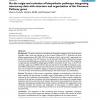Free Online Productivity Tools
i2Speak
i2Symbol
i2OCR
iTex2Img
iWeb2Print
iWeb2Shot
i2Type
iPdf2Split
iPdf2Merge
i2Bopomofo
i2Arabic
i2Style
i2Image
i2PDF
iLatex2Rtf
Sci2ools
BMCBI
2007
2007
On the origin and evolution of biosynthetic pathways: integrating microarray data with structure and organization of the Common
Background: The lysine, threonine, and methionine biosynthetic pathways share the three initial enzymatic steps, which are referred to as the Common Pathway (CP). In Escherichia coli three different aspartokinases (AKI, AKII, AKIII, the products of thrA, metL and lysC, respectively) can perform the first step of the CP. Moreover, two of them (AKI and AKII) are bifunctional, carrying also homoserine dehydrogenasic activity (hom product). The second step of the CP is catalyzed by a single aspartate semialdehyde dehydrogenase (ASDH, the product of asd). Thus, in the CP of E. coli while a single copy of ASDH performs the same reaction for three different metabolic routes, three different AKs perfom a unique step. Why and how such a situation did emerge and maintain? How is it correlated to the different regulatory mechanisms acting on these genes? The aim of this work was to trace the evolutionary pathway leading to the extant scenario in proteobacteria. Results: The analysis of the struc...
| Added | 12 Dec 2010 |
| Updated | 12 Dec 2010 |
| Type | Journal |
| Year | 2007 |
| Where | BMCBI |
| Authors | Marco Fondi, Matteo Brilli, Renato Fani |
Comments (0)

